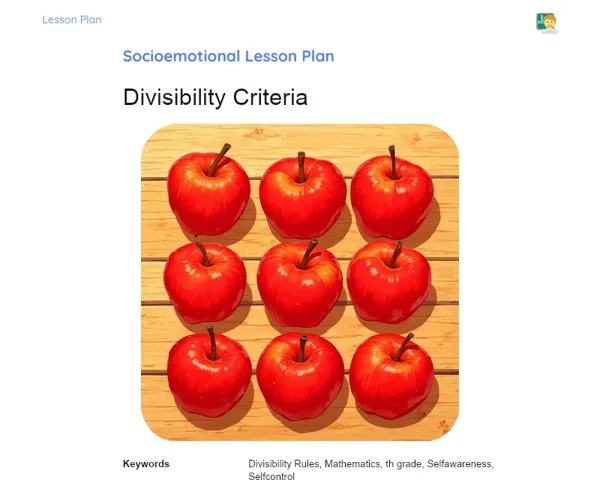Lesson Plan | Lesson Plan Tradisional | Writing Natural Numbers
| Keywords | Natural Numbers, Decimal System, Position of Digits, Reading Numbers, Writing Numbers, Leading Zero, Practical Examples, History of the Decimal System |
| Resources | Whiteboard or chalkboard, Markers for the whiteboard or chalk, Projector (optional), Posters with numbers and positions, Sheets of paper for notes, Pens or pencils, Printed support material (e.g., examples of numbers and their readings/writings) |
Objectives
Duration: (10 - 15 minutes)
The aim of this section is to kick off the lesson by clearly outlining the objectives. This clarity will help guide the students and set the stage for their understanding of what they are expected to learn by the lesson's conclusion.
Objectives Utama:
1. Teach students to read and write natural numbers in the decimal system.
2. Help students grasp the significance of the position of digits in determining the value of a number.
Introduction
Duration: (10 - 15 minutes)
The intention of this stage is to introduce the topic and clarify the lesson's objectives, enabling students to understand what is expected of them by the session's end.
Did you know?
Did you know that the decimal system we use nowadays traces its roots back to the ancient Hindu-Arabic civilization? Arab mathematicians introduced this system to Europe. It’s fascinating to consider that something we utilize every day has such a rich and ancient background!
Contextualization
Begin the lesson by asking students how many of them have gone grocery shopping or accompanied their parents to the shops. Explain that we use numbers daily for various tasks, like counting items we're purchasing, figuring out the change when we buy something, or calculating how many days are left until a special occasion. The numbers we refer to are known as natural numbers, and today we will learn how to read and write them accurately.
Concepts
Duration: (40 - 50 minutes)
This stage aims to deepen students’ knowledge in reading and writing natural numbers in the decimal system. Addressing specific topics and using practical examples will help students appreciate the importance of digit positioning while providing opportunities to practice correct number writing. The proposed questions will enable students to apply their learning and reinforce their understanding.
Relevant Topics
1. Decimal System: Clarify that the decimal system relies on ten symbols (0 through 9) and that each position in a number signifies a power of ten. Emphasize that the positioning of a digit dictates its value.
2. Positions and Values of Digits: Explain how each spot in a natural number corresponds to a specific value (unit, ten, hundred, etc.). Use relatable examples to illustrate how a digit's value varies based on its position.
3. Practical Examples: Provide practical examples of natural numbers, such as reading and writing various sizes (e.g., 345, 1,234, 56,789). Show how each digit plays a role in the total value of the number.
4. Writing Numbers in Words: Teach students how to express numbers from digit form to written form (e.g., 345 becomes three hundred forty-five). Discuss the grammar and agreement rules necessary for accurate writing.
5. Leading Zero: Discuss the irrelevance of leading zeros in natural numbers (e.g., 007 equals 7). Highlight the reasons behind this and how to approach reading and writing numbers correctly.
To Reinforce Learning
1. Write the number 1,234 in words.
2. Identify the positional value of each digit in the number 5,678.
3. Convert the phrase 'five hundred sixty-seven' into numerals.
Feedback
Duration: (20 - 25 minutes)
This phase aims to consolidate and review what students have learned, ensuring that they comprehend how to read and write natural numbers and appreciate the importance of digit positions. The discussions and reflective queries will encourage students to articulate their understanding and clarify any uncertainties, fostering a deeper grasp of the content.
Diskusi Concepts
1. ✅ Write the number 1,234 in words: The number 1,234 is read as 'one thousand two hundred thirty-four'. It's notable that the '1' occupies the thousand position, the '2' is in the hundred position, the '3' is in the ten position, and the '4' is in the unit position. 2. ✅ Identify the positional value of each digit in the number 5,678: In 5,678, '5' is in the thousand position worth 5,000, '6' is in the hundred position worth 600, '7' is in the ten position worth 70, and '8' is in the unit position worth 8. 3. ✅ Write the number 'five hundred sixty-seven' in numerals: 'Five hundred sixty-seven' is expressed as 567. Here, '5' is in the hundred position, '6' is in the ten position, and '7' is in the unit position.
Engaging Students
1. 📝 Question: If you wrote the number 2,345 with a leading zero (02,345), would it change its value? Why do you think that is? 2. 📝 Reflection: Why is it crucial to understand the position of digits in numbers? How does this knowledge play a role in daily life? 3. 📝 Question: How would you express the number 'two thousand twenty-one' in numerals? 4. 📝 Reflection: Can you think of other situations in everyday life where being able to read and write natural numbers is essential?
Conclusion
Duration: (10 - 15 minutes)
This section's goal is to review the key points covered in the lesson, reinforcing the students' grasp on reading and writing natural numbers. By linking theory with practice and underscoring the relevance of the content to everyday life, this segment aspires to solidify learning and highlight the value of the knowledge gained.
Summary
['Grasped the decimal system and its reliance on ten symbols (0 to 9).', 'Understood the positions and values of digits in natural numbers (unit, ten, hundred, etc.).', 'Acquired the ability to read and write natural numbers of varying sizes.', 'Developed the skill to convert numbers between numeric and written forms.', 'Recognized that leading zeros in natural numbers are irrelevant.']
Connection
The lesson connected theory with practice by utilizing everyday examples, like grocery shopping, to demonstrate the significance of accurately reading and writing natural numbers. Engaging in problem-solving and practical activities enabled students to apply the theoretical knowledge in real-life scenarios, aiding comprehension and retention of the material.
Theme Relevance
Understanding how to read and write natural numbers is vital for countless daily tasks ranging from shopping to calculating change and planning events. Knowing how to position digits accurately helps prevent errors and provides clarity when communicating values and quantities. Furthermore, the historical context of the decimal system enriches the students' cultural learning.



